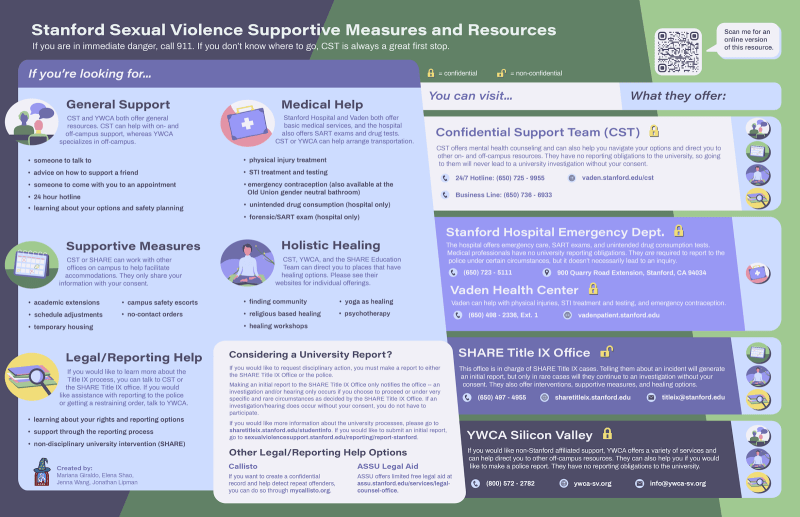In response to Stanford’s new Title IX policies, an Associated Students of Stanford University (ASSU) team has created multiple infographics to clarify the process for reporting sexual violence.
The University updated its policies and procedures in August in order to comply with new federal regulations, and the results were met with immediate controversy. Advocates say the infographics help to explain the “complicated” new process, but add that the University has a long road ahead toward making “survivor-supportive” policies. ASSU advocates said they were excluded from the revision process, and that the jurisdiction of the procedures is not broad enough. A student government committee recommended 25 changes to the draft of policies, only two of which were accepted.
After release of the procedures and backlash, University spokesperson E.J. Miranda wrote that advocates’ concerns were under review, and that the “procedures were released as pilots so that we could be nimble around making appropriate changes and the community is welcome to provide input.”
The ASSU created infographics to make the new process and procedures easier to understand and navigate. Jenna Wang ’22 and ASSU senator Jonathan Lipman ’21 were among the students who worked on the infographics through ASSU’s “Policy Wizards” branch — which assists in areas of “particularly complex public policy challenges,” according to Lipman. (Also among those who created the graphics is former Daily News Editor Elena Shao ’21 and Mariana Giraldo ’21.)
Wang wrote that the University had not done enough to explain the recently updated process to students in an email to The Daily, adding that students could only learn about it through a “50 page document filled with legal jargon” before the creation of the infographics. University SHARE Title IX Office produced a video that was sent to all students explaining the new procedures and other resources available to students, Miranda wrote.
Wang added that she hopes the posters will help “reduce the burden of having to go through such a traumatic experience” and will assist survivors in choosing “whatever path is right for them.”
The infographics break down Stanford’s Title IX process, explaining the differences between the SHARE Hearing Procedure, which applies to student or faculty member respondents, and the SHARE Investigation Procedure, which applies to staff and postdoctoral scholar respondents. Additionally, they indicate ways for students to submit confidential and non-confidential complaints.
The infographics were funded by Provost Persis Drell after students approached her with the idea, according to Miranda.
“Although we typically produce brochures of the procedures, when students offered to do the infographics it was an excellent opportunity to have the new procedures explained for students, by students,” Miranda wrote in the email. “The university was closely involved in the process and greatly appreciated the students’ work.” He added that their work is highlighted on Stanford’s Institutional Equity & Access homepage.
Marco Scalera ’23, an ASSU executive fellow for sexual violence prevention and Title IX, wrote in an email to The Daily that “Title IX is meant to protect students, and that should be what it does. Students should be aware of their Title IX rights.”
According to Wang, the “Policy Wizards” team gathered input from campus advocates, rather than Title IX officials only.
“We really felt that rather than only listening to officials at Stanford, we should also take into account what the students themselves had to say,” she wrote.
Sexual violence prevention advocates praised the infographics, while remaining critical of University policies themselves. Betsy Kim ’22, an ASSU executive fellow for sexual violence prevention and Title IX, who has previously written for The Daily, called the aesthetics “beautifully presented,” adding that the sexual violence reporting process was constantly changing and that the creators of the graphics should be prepared to update them frequently.
ASSU Co-Directors of Sexual Violence Prevention Julia Paris ’21, Krithika Iyer ’21 and Maia Elizabeth Brockbank ’21 wrote in a joint statement that it was important for students to understand their Title IX rights because the location, nature and timing of an incident, as well as the job category of the perpetrator, can all make the “same assault fall under different procedures.”
“These distinctions are not intuitive,” they wrote in an email. “Because Stanford’s new sexual violence policies are convoluted and difficult to understand, there is a significant barrier to entry for recently traumatized survivors.”
Paris, Iyer and Brockbank added that they applaud the students who developed the infographics.
Contact Katrina Machetta at katrinam ‘at’ missstem.org and Sam Catania at samcat ‘at’ stanford.edu.
